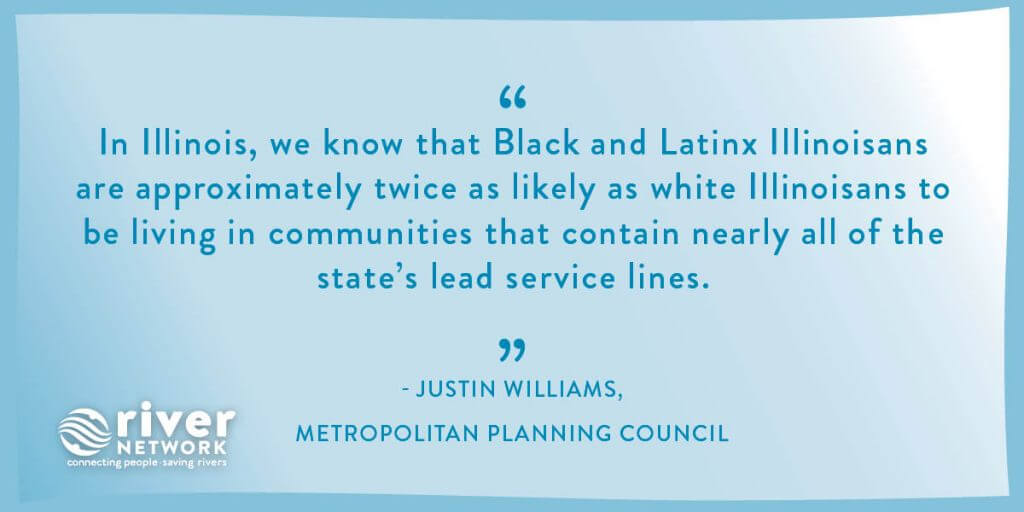Deep Dive: Addressing Lead in Water
Lead can cause serious health and developmental problems. Lead in drinking water infrastructure remains pervasive, despite the ban on using lead pipes in 1986. The removal of lead service lines (LSLs) averages around $5,000 per line, with an estimated 6 to 10 million lead service lines still in use. Lack of federal investment for inventorying where LSLs are located, improving protocols for testing water, and removing LSLs has left many communities at risk of contamination. The Flint, MI, water crisis garnered national attention in 2014. Transitioning from the Detroit River to the Flint River to source Flint’s drinking water stripped protective coating off of lead pipes, allowing the harmful substance to leach into residents’ drinking water. Residents fell ill, lost access to safe drinking water, and experienced a resounding loss of trust in local and state leadership.
Critiques of the US Environmental Protection Agency’s Lead and Copper Rule reveal flaws in water testing methodology and outdated standards for action alert levels. Many states have enacted legislation to develop lead testing and remediation pilot programs or programs that target vulnerable populations in facilities such as schools and childcare facilities. Midwestern states are leading the way towards a lead-free future, requiring the full removal of lead service lines within set timelines and prioritizing equitable funding and planning to address the issue, which disproportionately affects Black and brown, low-income communities. These policies are a step in the right direction toward lead-free drinking water in our communities.
Lessons from Michigan
Key Policy Language
Michigan’s 2018 revised Lead and Copper Rule (LCR) established a lead action level of 12 parts per billion (ppb), which will go into effect January 2025, and requires public water systems to replace full lead service lines throughout the state by 2041. Michigan’s prior LCR, and the current national LCR, have a lead action level of 15 ppb. Monitoring and inventory protocols were clarified and improved to ensure transparency, improve public education, and increase public advisory alerts. According to Michigan Department of Environment, Great Lakes, and Energy (EGLE), “An action level exceedance is not a violation but triggers other requirements to minimize exposure to lead and copper in drinking water, including water quality parameter monitoring, corrosion control treatment, source water monitoring/treatment, public education, and lead service line replacement. All community water supplies and nontransient noncommunity water supplies are subject to the LCR requirements.”
Consumer Reports
The revised LCR states, “Each community and noncommunity water supply that monitors for lead and copper… shall deliver a consumer notice of lead and copper tap water monitoring results to persons served by the water supply at sites that are tested.” Notification must occur within 30 days.
Drinking Water Advisory Council
“The director shall appoint a statewide drinking water advisory council to assist the department in developing lead public awareness campaign materials and advise the department on efforts to educate the public about lead in drinking water.”
Membership consists of: “1 community water supply representative, 1 noncommunity water supply representative, 1 representative of the administrative branch of a local government agency, 1 medical professional, 1 professor of public health at a university in the state, 1 representative of an environmental or public health advocacy group, 1 public health educator, and 2 members of the public at large.”
Lead Service Line Replacement
“Beginning the year after the preliminary distribution system materials inventory is complete, service lines under this subrule shall be replaced at a rate averaging 5% per year, not to exceed 20 years total for replacement of all service lines under this subrule.”
If a water supply “controls the entire service line… the supply shall replace the entire lead service line. If the supply does not own the entire lead service line, the supply shall notify the owner of the line, or the owner’s authorized agent, that the supply will replace the portion of the service line that it owns and the owner’s portion of the line at water supply expense. If the building owner does not consent, the supply shall not replace any portion of the service line, unless in conjunction with emergency repair.”
 Advocacy and Implementation Efforts
Advocacy and Implementation Efforts
Following the public outcry surrounding the Flint water crisis, Michigan regulators faced pressure to revise the state’s Lead and Copper Rule (LCR). Frontline community groups and environmental non-profits mobilized to submit comments, attend hearings, provide testimony, and exert their collective voice to increase protections from lead poisoning. Nick Leonard, Executive Director of Great Lakes Environmental Law Center (GLELC), advocates for stringent compliance with the federal and state Lead and Copper Rules. During the rulemaking process, GLELC helped partner organizations understand the proposed changes and incorporated their perspectives into their comments. The revised LCR was adopted in June 2018. Since the rule’s adoption, GLELC developed a handbook to address implementation issues and assist residents to act as watchdogs for their water systems and the state.
Watch Nick’s River Rally 2021 workshop, “How to Be a Lead & Copper Rule Watchdog.”
Other organizations like the Michigan League of Conservation Voters (MLCV) brought their organizing and communications expertise throughout the LCR revision process. MLCV developed a toolkit to help people submit comments, engaged in social media campaigns with partners, provided technical comments, and kept a close eye on more obscure processes, such as the educating the JCAR (Joint Committee on Administrative Rules) on the importance of the LCR changes (JCAR is the committee in the state legislature that has a role in reviewing rules and regulations).
Implementation Pushback
In the winter of 2020, GLELC, along with Natural Resources Defense Council (NRDC), challenged a practice by the Michigan Department of Environment, Great Lakes, and Energy that allowed partial lead service line replacement. Leonard explained that, “They were allowing a few communities to continue to conduct partial lead service line replacements, despite that being specifically prohibited by Michigan’s Lead and Copper Rule. We submitted a formal petition to the Department basically saying that we thought their practice was illegal and that they needed to immediately stop it. And they did.” Partial lead service line replacement increases the likelihood of spikes in lead contamination due to the disruptive nature of the process and a part of the lead line remaining. Full replacement of the entire lead service line is a best practice for lead remediation in drinking water.
Funding for LSL Replacement
There are an estimated 500,000 LSLs in Michigan. The LCR revision required each water system to develop a distribution system materials inventory by January 2020. With a 20-year deadline to replace all service lines in Michigan, funding for such projects will need support from the state. The revised LCR did not address how LSL replacement will be paid for. In October 2020, $102 million of funding for LSL replacement was announced for disadvantaged communities as part of a water infrastructure plan by Governor Whitmer. The funds came from a one-time transfer from the state’s Clean Water State Revolving Fund to the Drinking Water State Revolving Fund. Eligible disadvantaged communities that apply will have nine percent of their total loan forgiven through principal forgiveness.
In addition to the Disadvantaged Community Lead Service Line Replacement Program, the Drinking Water Asset Management (DWAM) grant, another component of the MI Clean Water infrastructure plan, is available to assist water suppliers in asset management plan development or updates, and/or distribution system materials inventory as defined in Michigan’s Lead and Copper Rule. Funding from federal Covid-19 relief to the state will likely help alleviate the burden of paying for LSL removal as well.
The University of Michigan’s Water Center developed several policy memos on the financing options for LSL replacement in the state. The Water Center’s recommendations include using the State Drinking Water Revolving Fund, state legislative action authorizing the use of utility revenues for funding full LSL replacements, and encouraging local governments and utilities to come up with a proactive plan for comprehensive removal and educating the public on the importance of LSL removal.
Lessons from Illinois
Key Policy Language
Based on a 2018 service line material inventory, Illinois is estimated to have over 680,000 lead-based service lines still in operation. In 2021, the Lead Service Line Replacement and Notification Act created a timeline for inventorying and replacing all lead service lines in Illinois, banned partial lead service line replacement, and developed a progressive fund to allocate money for infrastructure projects. Funding will come from billed water usage based on census tract median household income, prioritizing the removal of LSLs in low-income communities where LSLs are most prevalent. Replacement rates and timelines will vary by community water supply depending on the number of LSLs present, with completion times ranging from 15-50 years. Excerpts of key policy language are outlined here:
Lead Service Line Replacement Fund
“The Lead Service Line Replacement Fund is created as a special fund in the State treasury to be used by the Agency and the Department of Commerce and Economic Opportunity… The Fund shall be used exclusively to finance and administer programs and activities specified under this Act… The objective of the Fund is to finance all activities associated with identifying and replacing lead service lines, build Agency capacity to oversee the provisions of this Act and provide related assistance…”
5% of the Fund will specifically be allocated for “assistance to low-income communities in identifying, inventorying, planning for replacement of, and implementing plans for replacement of lead service lines.”
75% of the Fund will go to “costs related to replacing lead service lines.”
Effective January 2022, a Lead in Drinking Water Protection Fee will be instated, based on the median household by census tract. The Act includes the range of fees calculated by 1,000 gallons of billed water, collected by community water supplies. “The Department of Revenue shall deposit all proceeds from the lead in drinking water protection fee… into the Lead Service Line Replacement Fund.”
Lead Service Line Replacement Plans
Every community water supply must submit, by “April 15, 2023, its initial lead service line replacement plan to the Agency for approval.”
Final and complete replacement plans must be submitted by April 15, 2027 for Agency approval. The final plans must include “the total number of service lines connected to the distribution system of the community water supply; the total number of suspected lead service lines connected to the distribution system of the community water supply; the total number of known lead service lines connected to the distribution system of the community water supply; the total number of lead service lines connected to the distribution system of the community water supply that have been replaced each year beginning in 2018; a proposed lead service line replacement schedule that includes one-year, 5-year, 10-year, 15-year, 20-year, and 25-year goals… the estimated total number of remaining years until all known lead service lines have been replaced or suspected lead service lines have been determined to be made of materials other than lead… an analysis of costs and financing options for replacing the lead service lines connected to the community water supply’s distribution system.”
The plans must prioritize the replacement of lead service lines “that provide water service to high-risk facilities, such as preschools, day care centers, day care homes, group day care homes, parks, playgrounds, hospitals, and clinics.”
When replacing water mains, community water systems must also replace “any and all portions of each lead service line connected to that water main that are composed of lead.”
Equity and Diversity
The Act outlines requirements for workforce inclusion in the implementation of community water suppliers’ plans. Contractor and vendor requirements include “Ensuring that an amount of program portfolio incentive funding proportional to the population of persons who are Black, Indigenous, or persons of color within each county in which the owner or operator of a community water supply is located.”
Community water supply owners must ensure that “contractors and vendors pay employees working on lead service line replacement programs at or above the prevailing wage rate.”
The Lead Service Line Replacement Advisory Board must include “no less than 10 of the 19 voting members shall be persons of color, and no less than 3 shall represent communities, defined or self-identified as environmental justice communities.” The Advisory Board resides within the Illinois Environmental Protection Agency.
When working on LSLs, written notice by a community water supply that “serves a significant proportion of non-English speaking consumers, the notifications… must contain information in the appropriate language regarding the importance of the notice and a telephone number or address.”
Low-Income Water Assistance Policy and Program and Customer Assistance Programs
See the Affordability Deep Dive for more information on the Low-Income Water Assistance Policy.
The Act directs the Department of Commerce to establish “a comprehensive, low-income water assistance policy and program that incorporates financial assistance and includes, but is not limited to, water efficiency or water quality projects, such as lead service line replacement, or other measures to ensure that residents have access to affordable and clean water.”
“Any person who is a resident of the State and whose household income is not greater than an amount determined annually by the Department may apply for assistance… In setting the annual eligibility level, the Department shall consider the amount of available funding and may not set a limit higher than 150% of the poverty guidelines.”
The Department “shall ensure that the highest amounts of assistance go to households with the greatest water costs in relation to household income. The Department may consider factors such as water costs, household size, household income, and region of the State when determining individual household benefits… the Department shall ensure that a minimum of one-third of the funds for the program are available for benefits to eligible households with the lowest incomes and that elderly households, households with persons with disabilities, and households with children under 6 years of age are offered a priority application period.”
Additionally, the Illinois Commerce Commission “may allow or direct a water utility to establish a customer assistance program that provides financial relief to residential customers who qualify for income-related assistance… The Commission shall adopt rules to implement this subsection. The rules shall require customer assistance programs under this subsection to coordinate with utility energy efficiency programs and the Illinois Home Weatherization Assistance Program for the purpose of informing eligible customers of additional resources that may help the customer conserve water.”
Advocacy and Implementation Efforts
 Years in the Making
Years in the Making
Illinois Representative Lamont J. Robinson (D-Chicago) introduced the Lead Service Line Replacement and Notification Act (HB 3739) with support from a broad coalition including Natural Resources Defense Council NRDC, Little Village Environmental Justice Organization, Blacks in Green, Illinois Environmental Council (IEC), Illinois Pipe Trades Association, and Metropolitan Planning Council (MPC). MPC’s Policy Manager Justin Williams explained that, “This wasn’t the first year that we ran it, so it was a long-term effort, and I think there’s a sense that Illinois really needs to tackle this problem. Illinois has more lead service lines than any other state in the country… and Chicago has nearly 400,000 known lead service lines, which is more than any other city by a long shot… The scale of the problem was really clear and the threat to Illinois residents was also equally clear.”
Advancing Equitable Infrastructure
The Metropolitan Planning Council advocates for clean, affordable water through research, with a goal of being able to partner with utilities, municipalities, and affected communities. Using data from the state’s lead service line inventory (established through SB 550 in 2017), MPC established the strong relationship between the risk of exposure to lead service lines and race to understand the equity implications of water infrastructure and public health. Williams underscored their finding that, “In Illinois, we know that Black and Latinx Illinoisans are approximately twice as likely as white Illinoisans to be living in communities that contain nearly all of the state’s lead service lines.” Using the data from across 50 municipalities, MPC and their partners were able to connect the reality on the ground to specific legislators to reinforce the fact that their constituents were impacted by the issue.
Check out Waterloop’s episode on Illinois’ lead legislation, featuring Justin Williams and Jeremy Orr of Earthjustice, for more insights on the passage of this landmark legislation.

 From Illinois Environmental Council’s Iyana Simba’s perspective, the Flint water crisis served as a harsh wakeup call that invigorated public awareness of the dangers of lead in water. She recognized that, “There needs to be a statewide program, and there needs to be state funding, because we can’t keep pushing down the line. Flint was a very unique situation, but anywhere there’s lead, there could be another Flint crisis.”
From Illinois Environmental Council’s Iyana Simba’s perspective, the Flint water crisis served as a harsh wakeup call that invigorated public awareness of the dangers of lead in water. She recognized that, “There needs to be a statewide program, and there needs to be state funding, because we can’t keep pushing down the line. Flint was a very unique situation, but anywhere there’s lead, there could be another Flint crisis.”
Bringing a wide range of stakeholders to the table was a crucial part of the successful passage of Lead Service Line Notification and Replacement Act. IEC leveraged their long-term relationships with elected officials to build support, included the perspectives of communities with direct experience with water issues, and also made sure to reach out to utilities and municipal leadership early on in the process to help craft a solution that would work for them as well.
Looking forward, advocates hope that the Lead Service Line Replacement Advisory Board, which was established within the Act, will be one body they can track and interact with to ensure that implementation goes well. The low-income water assistance policy and program established within the Act also comes at a time when the federal, temporary Low-Income Household Water Assistance Program gets underway. How Illinois will implement the different programs to serve low-income residents remains to be seen. See the Deep Dive on Affordability to learn more.




